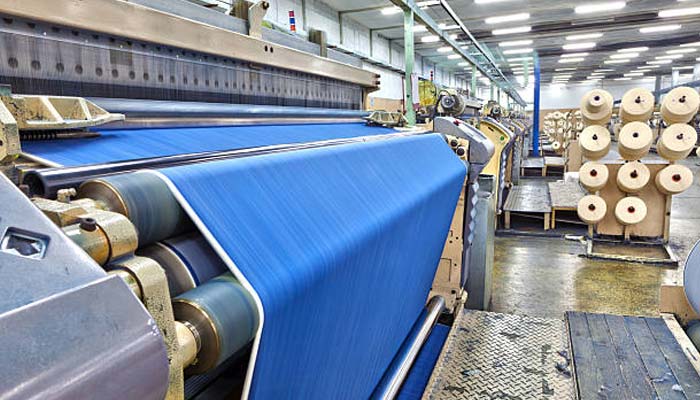By Jackie Warehime & Kasi Martin
By the time I finished my four-hour road trip last weekend, I’d accumulated two plastic bottles, a gas station snack wrapper, and a plastic veggie bag. I hadn’t planned ahead for the drive and was disappointed in my plastic output (and the general sentiment that this burden falls entirely on the consumer).
Plastic, today, is unavoidable. Even in fashion, fossil-fuel-based synthetics like polyester and acrylic have become staples because they’re cheap and versatile. In fact, 60% of global fiber production today comes from these virgin synthetics, meaning non-recycled, petroleum-based materials. ICYMI: Yes, we’re literally wearing plastic.
We’ve written about the issues with wearing plastic widely. (Check those out here and here). But for the TL:DR, plastic clothing pollutes the environment, perpetuates our dependence on fossil fuels, and poses a substantiated health risk to both the wearer and the producer. A single laundry load of polyester clothes sheds between 640,000 and 1.5 million plastic microfibers per wash, and can take up to 200 years to decompose when it ends up in landfills. Continuing to use virgin synthetics will create an unsustainable future, one none of us wants to live in. Not to mention the extra sweat in these extra hot times.
There are currently two “solutions” on the market to solve for our petulent plastics problem: one you’ve likely heard of—recycled synthetics that turn plastic waste into new fabric, and a newer alternative—bio-synthetics grown from plants. Here we’ll assess if these solutions are as great as they seem, and if either could build a genuinely sustainable future.
The Recycled Synthetics Approach
Some brands turn bottles into bottoms, and more…
You can find one potential solution in my closet: a pair of Rothy’s flats, made from recycled plastic bottles. It seems like a win-win—bottles that would go to waste get reused, and the virgin synthetics that would have been required are avoided.
The Promise: Transform existing plastic waste into new fabric. Your water bottles become workout leggings and fishing nets become swimwear. It’s circular, it’s clever, and it tackles two problems at once.
The Reality Check:
While some brands commit to using meaningful percentages of recycled content, many others don’t. Clothing labels with vague references to “recycled materials” can be misleading—companies can slap on a sustainability halo while using less than 10% recycled fiber. Even when garments are truly made from recycled synthetics, they still, shed microplastics, don’t biodegrade, and pose health concerns when worn close to the skin. In fact, some researchers question whether rPET may carry more harmful chemical residues due to its previous life as food-grade plastic, though the science here is still early and underfunded.
And let’s be crystal clear about the biggest issue: recycled polyester (or “rPET”) is more of a quick fix than a long-term solution. Most rPET comes from plastic bottles, which can typically only be recycled into fabric once before degrading in quality. That means it’s not truly circular—it just delays the inevitable trip to landfill and still perpetuates more fossil fuel usage.
Recycled polyester buys us time, but doesn’t solve the fundamental plastics problem.
Until the industry makes breakthroughs in safe, scalable alternatives—like bio-based synthetics or molecular and chemical recycling—your best move is to reduce synthetics overall. Look for pieces with less than 10% polyester content, especially in clothes worn close to skin or during workouts. When you do buy synthetics (we get it, the stretch is necessary sometimes), opt for high-quality, recycled versions from transparent brands. And look for chemical certifications like OEKO-TEX on product tags and descritipons. You can also wash your synthetic garments in a microfiber-catching bag or filter to reduce microplastic pollution.
The Bio-Synthetics Revolution

It’s critical to know the difference between chemical-intensive semi-synthetics like Bamboo and better alternatives like Tencel
Another option is to make synthetics without fossil fuels and instead create man-made materials from natural sources. Going this route means turning plant-based materials into into fabrics that mimic synthetics.
The Promise: Use renewable plant materials as the base for synthetic-like performance. Get the stretch, durability, and (hopefully) affordability of synthetics without the fossil fuel dependency.
The Reality Check:
Many “first wave” bio-synthetics or rely on harsh chemical processing (this is why they’re called “semi-synthetics” in the industry). Take viscose rayon: it’s made from wood pulp, but the transformation requires carbon disulfide, a toxic solvent linked to health issues and environmental damage. The same goes for “bamboo” rayon, which often sounds eco-friendly but is chemically identical to viscose—processed with the same intensive solvents that undercut bamboo’s sustainability cred. (We like to call brands out when we see this!). Even ramie, a bast fiber from the nettle plant that’s naturally strong and biodegradable, is frequently blended with synthetics to improve softness or performance, which complicates recyclability and end-of-life impact.
The exception in first wave bio-synthetics? TENCEL™ lyocell, made by Lenzing. It’s also derived from wood pulp, but the key difference is its closed-loop process: over 99% of the non-toxic solvent used is recovered and reused, drastically reducing emissions and water pollution. It’s one of the few commercially available options that balances performance, comfort, and real-world applicability. While it’s starting to gain mass marketpickup, it’s a softer fabric that’t more often used in everyday apparel and not as suited for athletic or techinical apparel..
Note: If you do choose TENCEL, look for FSC-certifiications or standards around forest management. Even with better tech, wood-pulp sourcing can still drive deforestation if it’s not coming from responsibly managed forests.
What a Sustainable Synthetic Future Actually Looks Like
Imagine we’ve solved this puzzle. We no longer wear virgin, petroleum-based synthetics, and we’ve addressed the limitations of today’s alternatives. What does that future look like?
For Recycled Synthetics: The system would grow increasingly less reliant on virgin fossil fuels as inputs until they became obsolte. Advanced recycling technologies would handle textile-to-textile recycling more effectively. And brands would design products with circularity in mind from the outset. Check out Cradle-to-Cradle if you want a true vision for that future. Eventually, we’d transition to “second-wave” bio-based recycled materials rather than fossil-fuel-based ones.
For Bio-Synthetics: This “second-wave” of bio-synthetics would use plants that don’t contribute to monoculture and processing that skips harsh chemicals, allowing the final product to biodegrade naturally. The materials would perform like traditional synthetics (without the crunch factor of cotton), but would return to the earth to nurish the soil when their useful life ends.
How Close Are We Today?

Companies like Amercycle are pioneering new methods of synthetic recycling using molecular science
Closer than you might think, but not close enough to solve the problem overnight.
Recycled Synthetics
Today, less than 1% of synthetic textiles globally are produced from recycled materials. While progress is slow, a few companies are advancing chemical and molecular recycling — processes that break synthetics down to their raw building blocks and rebuild them into new fibers, without the quality loss of mechanical recycling.
- Ambercycle is developing circular polyester using molecular regeneration. Their process transforms old polyester garments into new yarn with virgin-like quality.
- Carbios, a French biotech firm, uses enzymatic recycling to break down PET (from bottles and clothing) into base molecules for endless reuse. Collaborators include Patagonia and Puma.
- Debrand partners with Eastman Chemical, a pioneer in carbon renewal technology. Eastman turns apparel waste into Naia™ Renew, a fiber made from recycled and FSC-certified wood pulp. In a 2024 pilot, Debrand diverted 5,000 pounds of apparel waste to Eastman’s closed-loop process—marking real momentum toward circularity.
Bio‑Synthetics

Sugarcup is coming for the synthetic elastane in your next bra…
The second-wave of plant-based and biotech materials are leaving the lab and entering the market, offering performance without the petroleum. Some mimic synthetics like polyester or spandex, others aim to outperform them altogether—with lower impact and better end-of-life options. Here are a few standouts: :
- Kintra Fibers: A corn-based polymer that mimics polyester’s stretch and strength but biodegrades naturally. It’s already being piloted by Pangaia.
- BananaTex: Made from the Abacá banana plant, this fabric is biodegradable, naturally water-resistant, and grown in reforestation-friendly systems.
- BioPuff by Saltyco: A plant-based fill for outerwear that rivals down or polyester—lightweight, warm, and biodegradable.
- Spiber: A Japanese startup developing Brewed Protein™ fibers inspired by spider silk. Still emerging, but with major fashion partnerships already underway.
- Creora® bio-based elastane (Hyosung): A sugarcane-based spandex alternative that reduces reliance on fossil fuels. It’s not biodegradable, but it’s a lower-impact choice for stretch in activewear.
- Sugarcane-based EVA foam by Sugarcup™: Used in bra cups and swimwear padding, this foam replaces petroleum-based PU with a sugarcane ethanol blend—70% lower carbon impact, recyclable, and safer next to skin.
Natural Fibers That Punch Above Their Weight
They’re not new, but they’re powerful. With the right processing, Merino wool and hemp can match synthetic performance—minus the plastic.
- Merino wool: When spun ultra-fine (typically 17–19 microns) and knit for stretch, Merino becomes a technical powerhouse—naturally odor-resistant, moisture-wicking, breathable, and thermoregulating. With proper construction, it rivals synthetics for activewear, travel, and base layers—without the plastic or the stink.
- Hemp: One of the most sustainable crops around — it grows quickly, requires little water, and naturally resists pests. When blended thoughtfully or softened with enzymes, hemp offers durability and breathability that can replace poly-heavy basics, especially in warmer climates. Kasi has written about the processing developments in this space widely (here and here).
Note: Both fibers are often blended with a small amount of elastane (a plastic-based fiber) to improve stretch and shape retention—so check labels and aim for blends with 5% or less to keep synthetics to a minimum.
What You Can Do Today
While the industry works on better materials, we can make smarter choices that nudge things in the right direction—and avoid the worst offenders.
- Skip Virgin Synthetics: When alternatives exist, opt for natural fibers or certified recycled options instead of buying fossil-fuel-based synthetics.
- Read Labels Carefully: When option for synthetics, check for specific percentages of recycled content, not vague claims. Look for chemcal-free certification like OEKO-TEX in synthetics and semi-synthetics and FSC-Cerfified when buying wood-based fibers like Tencel. Whenever you can, prioritize brands using innovative bio-based or circular materials, and those that have transparent, ethical supply chains.
- Support the Right Brands: Swimwear and activewear often rely on synthetics—but not all are created equal. Check out our guides to better workout and winter wear to find brands investing in low-impact materials and better labor standards or browse the full shopping guide and refine for more.
- Buy Less, Care More: Take care of what you already own. Wash less, air dry, and use microfiber filters or bags to reduce shedding. The longer your clothes last, the less new plastic gets made.
The Bigger Picture
The future of synthetics isn’t about choosing between recycled bottles and banana plants. It’s about building systems that work—materials that perform without locking us into cycles of pollution, oil dependency, and waste.
Yes, the plastic from my old road trip water bottle will stick around for centuries. But the next generation of synthetics? They’ll be designed to go back to the earth as naturally as they came from it.
And that’s a future we should be designing for—not just wearing.
Jackie Warehime is a New York-based designer and sustainability advocate with a background in product design. She writes about sustainable design on Substack to explore and expand the ethical and sustainable approaches to crafting our world.


